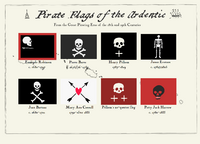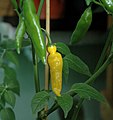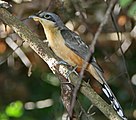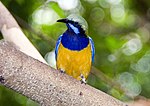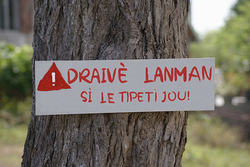Arecales

|
Arecales Arecales (Ingerish, creole) Capital: The Town (Arecales Town)
Population: TBD (2021) Motto: TBD Anthem: TBD |
Loading map... |
Arecales is an island territory in north Archanta. An overseas territory of the Federal States, it is composed of three large islands (Caya, St Catherine, Caraque) three smaller volcanic islands and many smaller cays, islets, rocks and banks. It is located about 1600km from the North Archantan mainland and 4940km from the nearest point in the continental Federal States. The territory has a surface area of 1946 km² (751 sq. mi.), of which three quarters of it is made up by the big island, and has a population of TBD inhabitants, including several thousand military personnel.
Settled and fought over by the Franquese and Ingerish over several centuries before becoming an FSA possessions, Arecales has a distinct culture that owing to both the distance and isolation, have developed a distinct regional cuisine, speak with a unique accent and dialect of Ingerish. Even among the islands of the territory there are differences in the dialect and culture. Tourism and offshore financial services have largely supplanted sugarcane and fishing as the largest sector of the local economy, and the Federal States military presence on Caya also contributes to the economy and infrastructure.
Etymology
The name for Arecales comes from "Arecales", the scientific name for flowering palms found on the island. The name came into use during the Franquese colonial period, though the name may have also been inspired by the Bai name 棕岛 (Zongdao), applied to islands which likely corresponded to the Arecales archipelago in the 14th century. St Catherine is named after St Catherine of Enzatta, a saint who had gained considerable popularity among sailors at the time of the island's discovery.
Toussaint is named after all saints day, because it was discovered on 1 November.
History
History of Caya
Early history
The legendary Bai explorer Kan She, who explored Archanta and journeyed south from the Kue Kingdom, had reportedly encountered the islets whom he called Zongdao, a reference to the many palm trees he saw. The first Bai and Kue settlers came to Caya around 1403 and established plantations on the island. The brief Bai-Kue settlement on the islets did not last long likely due to a volcanic eruption in 1420. [1]It is not believed that any Bai or Kue settlers found and/or settled on St Catherine.
Colonial period
The Castellanese explorer Guillermo de Berrio sighted Fitchett Island in 1542; he attempted to return in 1545 but was lost and never heard from again. In 1609 the Franquese explorer Henri de la Motte sighted the big island but did not land. He returned in 1610 but due to navigational discrepancies, he ended up at Fitchett Island and could not find the big island. La Motte planned a third expedition, and died before carrying it out, but his deputy, Jean Cagnet, found the big island, making landfall along the leeward side and formally annexing it in 1612.
The Franquese brought in slaves from Tarephia and central Archanta to work as laborers on the sugar cane plantations. Few Franquese actually settled on the island, most being colonial administrators, military personnel and their families. The main settlement was located near modern-day Windbreak Surf.
In 1672 Ingerland took the islands from the Franquese. This invasion was marked by the naval Battle of Arecales in June, fought some seven kilometres from the shore; Ingerland lost the Dauntless, though the invasion fleet sank the Draband and Belle Marie, as well as new ship of the line Guerrier.
The town at Windbreak Surf was destroyed by a hurricane in 1686, and a new settlement in what is not the old town was founded.
Caya was largely left to its own devices during Ingerish Civil War]. After 1717, resupply ships were reduced in frequency, less and less money from the treasury came and the colonial administrators resorted to issuing letters of marque to privateers on the islands to provide a source of income.
The most famous pirate of the era was Fernando Robinson, who operated out of his namesake village on the top end, and was rumored to have buried treasure near there. James Griffith was also notable in the era, who died attacking the town in 1723.
This first age of piracy was brief, ended with the Castellanese taking advantage of the weakened Ingerland and occupying the islands in 1722.[2] Several ships attacked Caya, landed marines on shore, and the disorganized pirates proved no match.
Ingerland took back Caya in 1730 and largely stamped out pirates, though pirates continued to operate out of various islets and cays. The most brazen pirate attack of the later 18th century occurred in 1772, the Ingerish had taken the Castellanese treasure boat Nuestra Señora de los Vientos and was taking her to the harbor at Caya when both she and her escort ship, Stoney, were attacked by unknown pirates; the larger treasure boat was sunk in the fighting and Stoney ran aground in the reef though crew were able to row out to shore.
Piracy
The independence of the Federal States saw diminishing need to maintain Caya, and more difficult to maintain resupplying it. Pirate attacks became more brazen from 1790, and shipping around the islands was increasingly disrupted, but increasingly little was done about the matter. Notable pirates of the era included:
- Henry Stead, known for his cunning, as pirate governor of Arecales from 1823.
- James Everson, likely mastermind of 1819 raid that "nearly took Caya without firing a shot". Died aboard his ship, the Alice Henry, sunk by Henry Pelham's ship.
- Henry Pelham, violent pirate. Died in 1829 at Ngu Long Son harbor, he entered the port and took several ships, but an armored boat fired a cannon shot that rip through Pelham's boat, wounded him before dying of infection.
- Mary Ann Connell, only known female pirate in Caya, may have been a prostitute in the town. Was involved with smugglers in Shaachrau and operated on the Kue coast in the mid-1820s. She attacked and destroyed part of Namthinhvuong in 1826.
- Petty Jack Harrow, born in Delenshire Island around 1780. Died with his ship in 1833 after being hunted and sunk by two FS navy ships. Was able to sink the FSS Caroline before his was crippled.
One of the most famous attacks occurred near the North Cay, when the violent and cruel Henry Pelham attacked the merchant vessel Milisle; as the ship resisted capture, he raised a red flag, and when she was boarded the captain was killed and supposedly lost his jaw before the ship was set on fire.
James Everson and Henry Stead launched a daring attack on The Town in 1819 with about 40 men aboard their boat, the Clara Lemington[3]. The governor of Caya bargained with the pirates and paid them off and hired them as privateers, but Everson and Stead fought at some point, and Stead joined Henry Pelham to attack and pillage the town in 1823. The Ingerish attempted to retake Caya in 1824, but their attempts to retake were defeated. The pirates began disrupting Ardentic trade routes, boarding ships, stealing cargo. The Ingerish retook Caya in 1828 but piracy would continue for over a decade, with pirates operating from other islands and cays in the area.
History of St Caths
Between 1733 and 1734 over 200 Caracan creole and Franquese families were deported by the Ingerish to St Caths. Most of these settled aroudn the Wells area and founded settlements like Bellecourt Saint-Anne, Dufresne, Fontaine Harbour and others. In 1804 the famous Wells rum distillery was founded in Wells town.
History of Caraque
Caraque was first explored by the Franquese around 1614 during Jean Cagnet's second voyage to the islands. Settlers from Caya were sent to settle the island with Louis Brunel appointed the first governor. Like in Caya, a sugarcane would become the main crop in the island and many slaves from Archanta were brought to work the fields. In 1672 The Ingerish successfully attack and took over Caya and subsequently sent what remained of the fleet to attack Caraque. The naval battle of Caraque proved disastrous for the Ingerish, several ships ran aground of the harbor of Basse-Terre (today Lazy Bay) and the Franquese defended the islands successfully. Following the Ingerish attack, the Franquese began building a small fortress in Basse-Terre, completed in 1680.
A hurricane in 1686 caused significant damage on the island; its believed that 500 or more people died, and the poor conditions resulted in a slave revolt that lasted for a few months until a company of troops was sent to the islands to restore order. Many slaves escaped over the mountains and founded the settlement of Monnet and were important in the settlement of the windward side. The conditions after the hurricane led to some fishermen and sailors engaging in piracy against shipping and especially the Ingerish colonies. The colonial governors officially were required to end piracy but tolerated it because of their action against the Ingerish. Piracy really increased during the Ingerish Civil War, taking advantage of the deteriorating conditions of Caya. Jean Barteau (c. 1680-1721) was a famous pirate in the period, and was active from the port of Saint-Jean, known as a pirate harbor, until his death at the hands of Henry Pelham. Pierre Barre (d. 1737) was also notable in this period, and since his death many have tried to find his treasure, which is buried on one of the cays between Caraque and St Caths.
In 1730 the Ingerish took back Caya after it fell to the Castellanese. Several pirates moved to Caraque and continued to operate against Caya. In response the Ingerish launched an attack against Caraque in 1732 to take the island and end piracy, and the Franquese were forced to give it up with a treaty in 1733. About 80 or 90 families were deported to St Caths in 1733 and over 120 in 1734, to try and reduce the Ortholic and Franquese concentration on the island. More were planned but were not carried out. During the independence wars of the Federal States, it became more difficult for the Ingerish to supply the islands and the Franquese retook Caraque in 1796 after a brief naval battle. Piracy attacks in the islands after 1800 threatened Caraque as well as Caya. In 1807 slaves rose up in several plantations on the island, and the slave revolt was aided when young pirate Petty Jack Harrow attacked Lazy Bay town. Order was restored by the Franquese in 1808 but by then pirates were living and operating from several towns on the island and nothing could be done.
Caya fell to pirates in 1823 and became a pirate state but Caraque was defended by Franquese, but was becoming expensive to defend. In 1828 the Ingerish took back Caya and they invaded and took Caraque in 1829, the last time the Franquese ruled the island.
In 1916 Miles Hill, the volcano on the island, erupted, and destroyed completely the village of Les Milles, and damaged heavily the towns of Haut Florise, Florise and Page Harbour. Many people were displaced to Sain John, Lazy Bay or moved to St Caths or Caya. The eruption damaged a lot of the crops and farmland of Florise Parish and caused economic issues on the island. More people emigrated to other islands in the following years, and today is seen in the lower population or Caraque versus other large islands of the territory.
History of Toussaint
The island was sighted by Louis Brunel during the voyage which brought first settlers to Caraque from Caya in 1615, it was seen on 1 November (All saints, or in Franquese Toussaint), which became name of the island. Because Toussaint was mountainous and didn't have a suitable harbor, there were no attempts to settle it. The defeat of a slave revolt in Caraque in 1686 saw a few escapes slaves leave the island on boats and 15 or 20 made it to Toussaint, helped by Cayan smuggler John Wills. Wills Harbour became the first settlement of the island, and a second village was founded on the south side of the island after 1750 (Toussaint). The island was sometimes visited by early buccaneers and pirates to resupply or find shelter.
Around 1710 Toussaint was formally occupied by the Franquese. After the Ingerish Civil War, the Ingerish reconquered Caya in 1730, and after fighting the Franquese, they acquired Caraque in 1733, which left Toussaint as the major Franquese territory. In the early 1800s Toussaint's geography helped it resist most pirate attacks; notably in 1812 James Everson destroyed the island's small harbor at Hole Beach. After the Ingerish invasion of Caraque in 1829, the peace treaty after made Toussaint an Ingerish island. Henry Stead escaped to Toussaint after the Ingerish took back Caya and is buried in a graveyard in Toussaint town.
In the 1960s the road in Toussaint was paved. In 1977 an airport was completed on the island, which reduced travel time to Caya from a 6 hour boat ride to a 55 minute airplane flight. In 1989 the local government approved a flag design for the island.
Geography
Caya
Caya is located around 10°N and 179°E, and comprises the easternmost part of Arecales. The big island is the easternmost settled area in the world. Arecales is made up of three islands and two cays. The largest, known as Caya or the Big Island, has an area of 424.6km² and contains the entire population of the territory. The two others islands, Fitchett Island and Cagnet, are both dominated by volcanoes that see many frequent and small-scale eruptions, with the Fitchett Peak believed to be the most active in the Federal States. Two smaller sandy cays also form part of the archipelago, as well as various minor cays, rocks, and banks.
Caya is normally divided into the windward side (the "western side") and the leeward side ("eastern side"). A ridge of hills raging from 62m to 133m go along the middle of the island, dividing it into the two aforementioned areas. The windward side has very few beaches due to a lack of natural breakwaters and sheltered areas, and is predominately marshy and scrubby coast, with various mangroves along it. The leeward side and top end of the island is sheltered by various coral reefs, banks and shoals, which make them calm waters and have various beaches. Some mangroves are found as well, but not to the extent of the windward side. The hills on the island are forested, though much deforestation has happened over the centuries as the main town expanded in area.
Cagnet Island is an active volcanic island. About half the island is covered by scree and rock, primarily in the center. Forested area still survives in many parts of the island, despite the rather large and violent eruptions of the past 50 years. Cagnet was the only other island beside the big one to have been inhabited for any length of time; the fishing village of Cagnet Town was founded in 1806 on the northwest coast and had about 200 inhabitants in 1971. The 18 June eruption of Cagnet Peak in 1971 saw the village destroyed by fast moving lahars, and some 80 of its inhabitants were killed. The lahars and mudflows changed the course of the river flowing through the town. The village ruins remain visible.[4][5]
Fitchett Island is an active volcanic island and is considered to be the most active volcano in the Federal States. Much of the island, at parts from sea level to the crater at the top, are dominated by a large swathe of rock and scree due to frequent eruptions. Above an elevation of about 170m, there is almost no vegetation left. The High Mountain Society operates manned research facilities at sea level and on the southeastern end of the crater, to monitor eruptions and volcanic activity.
St Catherine
St Catherine is the second largest island in the territory (561.7km²). The island is mountainous, with two major volcanoes, the largest of which (Mount Jacob), is 1027m high. The two volcanoes are still classified as active by the H.M.S., but there has not been a major eruption since 1453. The mountains divide the leeward and windward sides of the islands. The leeward side of the island is lush and beautiful, with lots of farming. The windward side of the island is rocky and less habitable than the leeward side, with few settlements. There are numerous small islets and cays surrounding the island.
Caraque
Caraque is the largest island of the territory (743.25 km²). The island is very green and is divided into windward and leeward side by a ridge of mountains, dominated by the 1029 m high volcano Miles Hill. The windward side is known for rocky coasts and beaches, while leeward side has many sheltered harbors and golden sandy beaches.
The territory of Caraque also includes three other cays, Petite Terre, Runaway Cay and Halyard Cay, none of these are inhabited.
Other islands
Toussaint
Toussaint is a small volcanic island, It is roughly square shaped, rocky and rugged and reaches 612m above sea level at the island summit. The volcano is possibly dormant.
Flora and fauna
Despite its small size, Arecales is home to a large and diverse variety of flora and fauna, with many fish, crustaceans, birds, insects, reptiles, trees, fruit and plants. In Caya there has been a variety of introduced and settled species that compete or live alongside the native species
The other islands in the territory have less human interference with the natural fauna aside from some animals for farming. In Toussaint, for example, goats and chickens are found throughout the islands.
Early Bai and Kue settlers in Arecales brought animals with them to Arecales in the 15th century; mainly they brought birds and gibbons as pets which likely escaped into the wild, but also snakes gecko's and other reptiles and insects are likely to have unintentionally been brought over. In the 17th to 19th century other birds from Commonwealth of Central Archanta were brought over during the period of the slave trade. Most of these animals are not currently considered problematic apart from a handful. The Gray's gecko has become one of the most common lizard types in Caya, supplanting most native species. White cheeked gibbons have and rhinoceros rat snake have become a nuisance in urban areas. The gibbons are also present in Serpentine and Diamond Cay, on Serpentine they bother tourists and locals to give them fruit.
Volcanic activity
Various island in the territory are volcanically active and contain some of the most active volcanoes in the Federal States. Fitchett Peak is considered to be the most active, with eruptions occurring every few months since 1996, most recently erupting in February 2020. Eruptions, while frequent, are not considered very dangerous nor terribly explosive, though have been known to delay air traffic in Arecales. The largest recorded eruption there took place in 1927.
Cagnet Peak is not as active, but has recorded a few larger eruptions, in 1963, 1971 and 2005. The 1963 eruption lasted a few days, with lahars flowing to the southwest and southeast. Both the 1971 and 2005 eruptions saw ash deposited on the military base, and led to the airport and airfield temporarily suspending flights. The 1971 eruption was considered the most explosive, with fast-moving lahars flowing northwest, destroying the fishing village of Cagnet Town and killing 80 people. Volcanic activity in 2005 was studied by a team of volcanologists from the High Mountain Society, but an earlier than anticipated eruption caught them near the summit and saw four scientists killed.
Climate
Most of Arecales is characterized by tropical rainforest climate. All of Caya, the Top Bank and Eastern Bank Cays and the smaller islands ass well as the majority of St Caths and Caraque fall in this weather. The highest areas of Caraque and St Caths might be classified as subtropical highland.
Politics and government
Government
As an overseas territory of the Federal States, there is a governor as the head of state representative, historically appointed by the Federal States president and who is based in Caya. Arecales has a unicameral legislature, the Territorial Council, with 20 elected representatives. Elections are held every four years, most recently in 2018, and the leader of the party with most seats is appointed by the governor as president of the government. The territory government also performs the role of government of Caya, but St Caths and Caraque have their own regional governments. The current governor of Arecales is Stacy Mayport.
Toussaint has two municipal governments, and the government of Wills Harbour is a combined municipal and island wide government.
Administrative divisions
Arecales is divided into three constituent parts (Caya, St Caths, Caraque) and three special municipalities. On St Caths, Parishs are called "Parcels".
Economy
Most of Arecales' economy is centered around the services sector, heavily focusing on tourism and financial services. Seafood, agriculture and food products are also important to the economy, but a smaller sector.
Tourism
Tourism is the traditionally largest economic sector in Arecales. Much of the tourism to Arecales is centered on cruise ships, resorts, hotels and private islands.
Financial services
Arecales (specifically Caya) is a significant offshore jurisdiction, licensing offshore companies and hedge funds. Corporations registered in Arecales are not subject to business taxation, making it a lucrative sector but also leading to claims of tax evasion and money laundering. Most of these are based or registered in buildings on Fleetwood Street, which is often used as a synonym for the offshore sector in Caya. Many goods, such as alcohol, tobacco, watches, jewelry and other luxury items are exempt from sales taxes (VAT), to attract shoppers and tourists.
Banking is an important part of the economic diversification of Arecales (specifically Caya) in the 1990s and 2000s. There are two main commercial banks in Arecales, most branches being of the local Commercial Bank of Caya/CBC Bank and a few of the FSA-based Western Bank. The two types of banks allowed in Arecales are "L" (local and able to do business with Arecales residents) and F (foreign-based customer banking services only). Some of these banks may not be physically present in Arecales but are registered in Caya.
| Name | Type | Phys. presence | Country of origin |
|---|---|---|---|
| ACG International | F | Yes | Alliria |
| Commercial Bank of Caya/CBC Bank | L | Yes | |
| Arecales International Bank | L/F | Yes | |
| BMN (Arecales) Ltd | F | Yes | Navenna |
| Hamilton Bank and Trust Ltd | F | Yes | |
| Island Investment Bank | F | Yes | |
| S&E Bank Ltd | F | Yes | |
| Western Bank | L | Yes |
Industry and agriculture
Agriculture and industry in Arecales is a very small sector of the economy. Agriculture is centered on sugarcane, with other centered on fruit orchards, primarily grapefruit. Pigs and some poultry are also farmed. The largest industry in Arecales is centered around rum distilling and some sugarcane refining, of which Tower Hill rums is the largest.
Fishing and aquaculture
Scallops and fish are important to the economy. Fish is main caught out in the ocean, though scallops are farmed and are a major industry.
International shipping
Arecales has an open registry for vessel registration, which means that there is no residency requirement to register a ship in Arecales. Registration fees for vessels contribute to the national economy. The shipping registry is maintained by the Arecales Maritime Authority, with offices in The Town and Lazy Bay, which is also responsible for implementing health and safety regulations and ensuring good qorking conditions on Arecales-flagged ships.
Businesses
Most businesses in the territory are small, locally owned and operated. There are a few foreign chains from FSA and elsewhere, such as GasIt and Tanaco (fuel), Western Bank, Yumburgers and Blue Wasp (restaurants), but only found in the bigger islands. There are a few local chains as well, either found only in Caya or throughout the whole territory:
- Digicom: mobile provider, present in all the major islands
- Arecales Commercial Bank, bank present in the main islands
- Marie's Fish and Fried, notable seafood and chicken restaurant chain in Caya
- Harriet, fuel station chain
Communications
Telephone
There are two mobile phone providers in Arecales, Digicom, which is a regional provider, and StarCellular, a Federal States company.
Radio and television
Arecales has a few radio stations: AR FM, WeRadio, Radio93 and Christic Radio Arecales. Television service is provided by Digicom, and there is an Arecales TV channel. Satellite communications has allowed access to Federal States and international television channels.
Postage
Arecales Post is the postage company on the territory. It is responsible for receiving and delivering mail in the island, and issues postage stamps for general use and for collectors. Arecales Post is based in the Spencer's Waterfront Mall (The Town, Caya) and is an associated entity of the Federal States Post.
Climate
Arecales has a fairly typical oceanic tropical climate. Arecales tends to have two seasons, a rainy "winter" from October to March, and a comparatively drier "summer" from March to October. Temperature do not vary greatly throughout the year, with only a few degrees of difference between winter/summer highs and lows. Annual temperatures normally range above 20°C to 30°C (70°F/86°F), but humidity is generally high. Tropical cyclones are common in Arecales and bring heavy rain, powerful winds.
Tropical storms
Arecales is in a prime location for tropical storms, and every year is hit with heavy rain through the winter. Tropical storms and hurricanes have been incredibly large in 2007, 2012 and 2013, causing a lot of damage to the island.
Culture
Cuisine
Arecalian cuisine is well known for its seafood. Scallops and fish are popular on the island and are best-known in the local cuisine. Hot peppers are important to the local cuisine, of which the native Petit (or Arecales Petit) Pepper is key to the local flavour. Different island also have unique cuisines using locally fished or grown products.
Due to the introduction of pigs by both the Castellanese and Ingerish in the colonial era, pigs have become plentiful and are used to make roast pig (or lechon), a popular dish served with yellow rice and peas.
Rum is the national beverage in Arecales, produced in large quantities.
Language
Ingerish is the most common spoken language in Arecales. There is no single Arecales accent, but the major islands have their own dialects of Ingerish which are similar to each other. In Caraque and also in Toussaint, many locals still speak a Franquese-based creole as their colloquial language. In Caraque, speaking kriol was considered to be uneducated for a long time and policies were established to favor speaking Ingerish. In the last ten years there has been a revival of kriol and it can be heard in more official settings as well as in private. The Caracan government established a campaign in early 2021, "Kriol, se la koutou karak" (Creole, its Caracan culture) to help increase literacy in creole and establish a dictionary of the language.
Festivals
Carnival/carnaval/kannaval is the is the major festival of the islands. Each of the major islands has its own festival, usually taking place until Mardi Gras before Ash Wednesday. The Cayan carnival is generally the largest and sees lot of visitors from overseas for carnival time.
Sports
Various sports are played in the territory. Cricket, introduced by the Ingerish, has become large and popular and is the most popular sport played. Arecales Cricket is the governing body for cricket in the territory. Cricket teams were set up in Caya (Cricketing Federation of Caya), St Caths (TBD) and Toussaint (Caraque Cricket Association), but generally competed internationally as the Arecales team as an associate of OGFIC (the international cricket body). Since 1999 there is a combined West Ardentic cricket team which often plays against other international sides. Stroll Road Cricket Ground is the main stadium of the islands, but there are many other cricket pitches.
There is a domestic T20 cricket league organized since 2017, the Digicom Arecales T20 Super League. There are five teams in the league.
| Team | City | Stadium | Captain | Head coach |
|---|---|---|---|---|
| Caraque Kaymans | Lazy Bay | Alton Park | ||
| Caya Pirates | The Town | Stroll Road∈⊾ | ||
| Hideaway Islanders | Fernando's Hideaway | Hideaway Playing Field | ||
| St Caths Royals | Kaetown | TBD | CCA Hendrie Riessen | |
| Toussaint Rebels | Toussaint | Toussaint Sports Ground |
Football (soccer) is also a popular sport, and you can find a variety of football pitches on the island, as well as a stadium. Since 1979 Arecales has a national team, comprised of amateur players. Due to Federal States influence, baseball is also present in Caya, having picked up a bigger following since the 1970s.
Caya has sports centres for tennis, and a swimming center with a Geolympiad-sized swimming pool. Dedicated track running facilities exist at Malcom Jennings Stadium. Arecales has competed at the Pax Nova games in middle distance running, swimming, sailing among other sports. They have not had much success, but the small team at the 2016 Quentinburgh games resulted in a medal, won in sailing by Cayan Cara Lowell-Hunt.
Religion
Christic religions are the most common religions on the island. Ortholic and various protestant religions form the majority of this, with all communities having at least a church. There are also mosques and synagogues, mainly in Caya. In Caraque there are people who practice the joujou religion, which combines traditional practices of the slaves brought over from central Archanta with Ortholic religion. Joujou religion has major figures like the Virgin Mary, the main figure of good, Mamitì (Mamie petite) and Rua Joujou (Joujou king), usually seen as a dark figure that must be appeased. Joujou religion was seen as witchcraft during the colonial and early FSA period, today there are several mezons (temples) in Caraque. Most people who practise the joujou religion also belong to a church, there is no issue in practicing both religions.
Music and film
Arecales is known for various music styles, with a focus on key instruments like acoustic guitars, marimbula, drums, and others. Arecalian music was first recorded in 1916 when the Stead's Band was brought to Stanton to record two sides. Becasse is one of the most popular styles from the 1950s, and the first to be recorded in great numbers. In the 1970s FSA funk records imported to Arecales gave influence to highbeat music. There is one record studio in Arecales, Tropic Studio on Stroll Road.
The 2021 action film Pirates of the Ardentic was partly filmed in Arecales, loosely based on the 19th century pirate history of the island. It is the first major movie to be filmed in Arecales.
- Cricketing Federation of Arecales logo.png
Cricketing Federation logo
- Piratesoftheardentic.jpg
Film poster
- Arecales 78rpm record - 1950s.png
1950s becasse
Transport
Arecales Airport is the largest civilian airport in Arecales. The runway is 2550m long and can accommodate various short and medium range propeller and jet aicraft. The only scheduled commercial flights from the FSA are operated by FlySmart out of Andreapolis International Airport in Alormen, a distance of about 5800km. Island Air operates a variety of daily flights to the main islands and other cays. There are other smaller air travel providers in the islands for charter and service to smaller locations, like Newman Heli Air (based in Windbreak Surf, Caya) and Michel Seaplane Ltd (Lazy Bay Caraque). Arecales Air Force Base receives all military travel to Arecales, as well as bringing in a lot of supplies. The longest runway, 3670m long, is designed to accommodate subsonic and supersonic bomber aircraft takeoffs.
St Caths has St Catherine Regional Airport, with a 1035 m runway, near Kaetown. Lyndon W. Barnet Airport serves Caraque, located near Saint John. There are several airports, heliports and seaplane ports in other islets and cays in the territory. Other disused runways include one at Petite Terre (former military) and on Pig Cay, which was second longest non military runway, used by drug smugglers until 1990s.
| Name | Type | Ref | Length | Notes |
|---|---|---|---|---|
| Arecales Airport | airport | 04L/22R | 2550 m | International airport |
| St Catherine Regional Airport | airport | TBD | 1035 m | Scheduled flights within islands |
| Lyndon W. Barnet Airport | airport | 09/27 | 1030 m | Scheduled flights within islands |
| Toussaint Airport | airport | 02/20 | 580 m | Scheduled flights within islands |
| Headley Airport | airport | 01/19 | 730 m | Limited scheduled flights within islands |
| Rock Bottom Airport | airport | 03/21 | 660 m | Limited scheduled flights within islands |
| Old Town Airport | airport | 16/34 | 725 m | Served by charter flights |
| Boguestown Airport | airport | 03/21 | 525 m | Under construction (2023) |
| Frigate Cay Airstrip | airport | 11/29 | 403 m | Private airport |
| Dellyse Cay Airport | airport | 10/28 | 500 m | Private airport |
| Hideaway Heliport | heliport | - | - | Private heliport |
| Waterfront Helipad | heliport | - | - | Private heliport |
| Williamstown Seaplane Base | seaplane base | - | - | Private seaplane base |
| Road Bay Seaplane Base | seaplane base | - | - | Private seaplane base |
Road travel
There is one main road in Toussaint, The Road. It was paved in the 1960s. Sylvain Potter is the taxi service on the island, a microbus and small jeep are operated by him and his son. Supreme Scooter Hire has several scooters and moped for rent.
Sea travel
Arecales Naval Station has the largest port on the island, having been expanded several times to allow for larger vessels. It can accommodate various vessels, from coast guard patrol boats, cruisers, transport/resupply vessels and aircraft carriers.
The main harbor (Arecales Harbour) is located near the old town in what was a natural sheltered mooring point. The port was begun by the Ingerish in 1702 and expanded through the early 2000s. The Arecales Ferry Port is found here, as is the cargo port. Cool's lagoon is the largest natural harbor, found on the top end of the island.
Other islands and cays
- In Boguestown there are ferry services from the terminal to Lazy Bay, small vessels can moor at the dock. There is a private yacht club on the other side of the town.
- There are ferry connections from Wills Harbour in Toussaint to the ferry port in Arecales and to Williamstown.
- Rock Bottom Cay has a small marina and ferry service to Caraque.
Notes and references
| States | Alcortez • |
|---|---|
| Capital District | Huntington(c) |
| Overseas Territories | |
- ↑ Small tools and artefacts of Kue origin found throughout the island largely attest to farming as the main focus.
- ↑ This makes Caya one of the few territories to have gone though the hands of the three major historical empires of the early modern era.
- ↑ The Clara Lemington was named after a famous prostitute of the period. A modern reconstruction of the ship is on display at Arecales Castle.
- ↑ The village had been evacuated on 2 June to Arecales Town when eruption seemed imminent, but a lull in volcanic activity saw most of them return on 14 June.
- ↑ The High Mountain Society warned against returning, but the fishermen could not afford to remain without working and sought to return.

